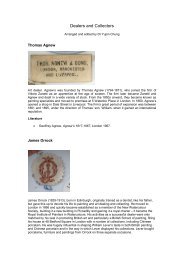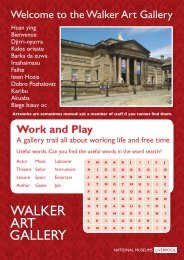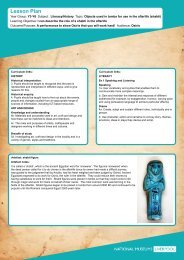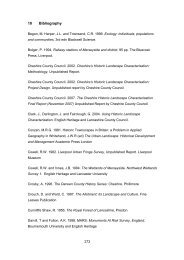Liverpool and the American Civil War no59.pdf - National Museums ...
Liverpool and the American Civil War no59.pdf - National Museums ...
Liverpool and the American Civil War no59.pdf - National Museums ...
You also want an ePaper? Increase the reach of your titles
YUMPU automatically turns print PDFs into web optimized ePapers that Google loves.
IntroductionMARITIME ARCHIVES AND LIBRARYINFORMATION SHEET 59LIVERPOOL AND THE AMERICAN CIVIL WAR<strong>Liverpool</strong>, <strong>the</strong> Wirral, Lancashire <strong>and</strong> most of <strong>the</strong> surrounding area, had strong political,emotional <strong>and</strong> financial connections <strong>and</strong> sympathies with <strong>the</strong> Confederate States of Americaduring <strong>the</strong> <strong>American</strong> <strong>Civil</strong> <strong>War</strong> (18611865). Indeed, so strong were <strong>the</strong>se connections that ithas been quoted that at one time "more Confederate flags fluttered above <strong>Liverpool</strong> thanover Richmond" (<strong>the</strong> Confederate capital in Virginia). 1One of <strong>the</strong> main reasons for <strong>the</strong> link was economical, based on <strong>the</strong> importance of cotton,upon which both <strong>the</strong> Sou<strong>the</strong>rn States <strong>and</strong> <strong>the</strong> Lancashire mills depended. However, <strong>the</strong> tieswere much deeper <strong>and</strong> emotional than purely economical ones, <strong>and</strong> <strong>the</strong> history of thisrelationship is still able to raise controversy <strong>and</strong> argument even today.The outbreak of hostilities in 1861 found <strong>the</strong> Sou<strong>the</strong>rn States in <strong>the</strong> worst position with <strong>the</strong>North having more manufacturing, arms production <strong>and</strong> industrial power. The South,because of its lack of resources, was forced to look to Europe. The already strong links from<strong>the</strong> cotton trade, made <strong>Liverpool</strong> <strong>the</strong> obvious choice for organising supplies <strong>and</strong> aid for <strong>the</strong>Confederacy. It was also important to keep open <strong>the</strong> supply line for cotton upon which <strong>the</strong>South <strong>and</strong> <strong>the</strong> Lancashire cotton mills depended. A fleet of Confederate blockaderunners<strong>and</strong> naval cruisers were built on Merseyside to keep this vital supply line open.James Dunwoody Bulloch, a Confederate naval officer, arrived in <strong>Liverpool</strong> on 4 June 1861with orders to buy or have constructed 6 steam vessels suitable for use as commercedestroyers against <strong>the</strong> Union, to be delivered, unarmed, under <strong>the</strong> British flag at anySou<strong>the</strong>rn port. In addition, he was to purchase <strong>and</strong> blockade run arms for <strong>the</strong> cruisers. Hewas assisted by Fraser, Trenholm & Co., foreign bankers to <strong>the</strong> Confederacy (see below).His first contract was with Fawcett & Preston Engineers (see below) <strong>and</strong> W.C. Miller & Son,Ship Builders, to build a steam sloop, CSS Florida, which was delivered in 1861. Thesecond contract was signed in July 1861 with Laird Bro<strong>the</strong>rs, for number 290 (known asEnrica). On <strong>the</strong> 29 July 1862, Enrica sailed to Anglesey for trials with various dignitaries onboard, <strong>and</strong> after putting <strong>the</strong>m off by a tug, quietly sailed off for <strong>the</strong> Azores to take onarmaments <strong>and</strong> ammunition from <strong>the</strong> Agrippina, <strong>and</strong> to begin life as <strong>the</strong> CSS Alabama.Alabama had mostly British <strong>and</strong> mainly <strong>Liverpool</strong> crew on board, as when she had left<strong>Liverpool</strong> under secrecy, after being given <strong>the</strong> choice, most of her c.30 <strong>Liverpool</strong> crewsigned on for <strong>the</strong> Confederate Navy. We hold a certificate of competency of GeorgeFreemantle, Quartermaster in <strong>the</strong> archives collection. (DX/1841)Captain Raphael Semmes took comm<strong>and</strong> of <strong>the</strong> Alabama on <strong>the</strong> 13 August, <strong>and</strong> from thattime until June 1864, she captured <strong>and</strong> burned 55 Union merchantmen worth $4,500,000<strong>and</strong> bonded ten o<strong>the</strong>rs to <strong>the</strong> value of $562,000. 2 On <strong>the</strong> 19 August, <strong>the</strong> Alabama met <strong>the</strong>USS Kearsage off Cherbourg, France, <strong>and</strong> after a spectacular battle watched by thous<strong>and</strong>son <strong>the</strong> French coast, <strong>the</strong> Alabama was sunk. Fortunately <strong>the</strong> steam yacht Deerhound (alsobuilt at Laird's) <strong>and</strong> owned by Englishman John Lancaster, saved a number of crew,including Captain Semmes <strong>and</strong> a number of officers, who were given a hero's welcome atSouthampton.The Alabama is known to have been photographed only twice in her brief career, once whenat Singapore (a profile distant view) <strong>and</strong> once in Table Bay, off Cape Town on 12 th August1863 when a photographer was allowed on board. Cape Town photographer Arthur Green,
took a series of photographs of Captain Semmes, 1 st Lt John Kell <strong>and</strong> several of <strong>the</strong> crew ondeck, <strong>and</strong> seven of <strong>the</strong> surviving images are held at Cape Town Archives, US NavalHistorical Center, George Eastman N York or in private collection. The Merseyside MaritimeMuseum acquired three of <strong>the</strong>se photographs in 2005.James Dunwoody Bulloch ordered several more ships from Laird's including <strong>the</strong> "Laird'sRams" (Nos. 294 & 295) which were impounded by <strong>the</strong> Government <strong>and</strong> later sold to <strong>the</strong>Royal Navy. The rams took <strong>the</strong>ir name from <strong>the</strong> iron piercer, which protruded six to sevenfeet from <strong>the</strong> prow <strong>and</strong> was used for striking opposing vessels below <strong>the</strong> waterline.After <strong>the</strong> end of <strong>the</strong> war, Bulloch remained in <strong>Liverpool</strong>, <strong>and</strong> died in 1901. He is buried inSmithdown Road Cemetery, Toxteth. In 1873, <strong>the</strong> United States Government's dem<strong>and</strong> that<strong>the</strong> British Government should pay compensation for <strong>the</strong> damage caused by <strong>the</strong>Confederate ships was settled. Known as <strong>the</strong> "Alabama Claim", because she had caused<strong>the</strong> most damage, <strong>and</strong> toge<strong>the</strong>r with <strong>the</strong> Florida <strong>and</strong> Shen<strong>and</strong>oah, had accounted for half of<strong>the</strong> total number of Union vessels captured. It resulted in <strong>the</strong> British Government paying£3,000,000 compensation for allowing <strong>the</strong> Confederate Government to purchase <strong>the</strong> ships inEngl<strong>and</strong> <strong>and</strong> allowing <strong>the</strong>m to use British ports.1. Merseyside Connections With The <strong>American</strong> <strong>Civil</strong> <strong>War</strong>, by John Townley (see below for fur<strong>the</strong>rdetails).2. Ghost Ships of <strong>the</strong> Mersey, by K.J. Williams, p. 18. "Bonded" meant that <strong>the</strong> captain of <strong>the</strong>captured ship signed an agreement that at <strong>the</strong> end of <strong>the</strong> war <strong>the</strong> value of <strong>the</strong> ship would be paidto <strong>the</strong> Confederacy.ArchivesThe Maritime Archives & Library holds many significant items <strong>and</strong> collections relating to <strong>the</strong><strong>American</strong> <strong>Civil</strong> <strong>War</strong>.Jones, Quiggin & Co., ShipbuildersJones, Quiggin & Co., was founded in 1855, <strong>and</strong> built composite <strong>and</strong> iron ships includingsailing vessels, paddle <strong>and</strong> screw steamers. Much work was for customers abroad, <strong>and</strong>included commissions for <strong>the</strong> Confederate Government, arranged through Fraser, Trenholm& Co. Ships built at this time include five blockade runners, one of which, <strong>the</strong> Banshee,became <strong>the</strong> first steel ship to cross <strong>the</strong> Atlantic in 1863.RecordsSpecification Book (includes several Confederate Blockade runners)(photocopy available in <strong>the</strong> Searchroom)DX/154/1 1855 1865Engraving of 5 ships launched from <strong>the</strong> yard of Jones, Quiggin & Co.,Illustrated London NewsDX/287/34 February 1865See below for specifications for <strong>the</strong> Rosine <strong>and</strong> papers relating to <strong>the</strong>ir o<strong>the</strong>r blockaderunning ships, <strong>and</strong> also for records relating to <strong>the</strong> construction of <strong>the</strong> Banshee.Fraser, Trenholm & Co., Cotton MerchantsThis unique collection consists of correspondence <strong>and</strong> o<strong>the</strong>r documents of Fraser, Trenholm& Co., Cotton Merchants of 10 Rumford Place, <strong>Liverpool</strong> (18601866), <strong>and</strong> a branch of JohnFraser & Co., Merchants of Charleston, South Carolina, USA. Fraser, Trenholm was aprominent commercial house in <strong>Liverpool</strong>. The firm's manager <strong>and</strong> senior partner, Charles
Kuhn Prioleau, was a naturalised Englishman, who had been brought up in Charleston,South Carolina. The senior partner of <strong>the</strong> English branch of Fraser, Trenholm & Co., basedin Charleston, George A. Trenholm, became Secretary to <strong>the</strong> Confederate States Treasuryin 1864. The <strong>Liverpool</strong> firm made an enormous contribution to <strong>the</strong> war effort of <strong>the</strong> South,acting as banker to <strong>the</strong> Confederate Government <strong>and</strong> financing <strong>the</strong> supply of armaments inreturn for cotton.Fraser, Trenholm also participated in blockade running, organising <strong>the</strong> building of ships suchas <strong>the</strong> CSS Alabama, <strong>and</strong> assisted in <strong>the</strong> floating of Confederate loans <strong>and</strong> generallyencouraged support in Europe for <strong>the</strong> South. The collection provides a unique insight into<strong>the</strong>se activities. Many of <strong>the</strong> major protagonists in <strong>the</strong> <strong>Civil</strong> <strong>War</strong> are mentioned in <strong>the</strong>letterbooks <strong>and</strong> correspondence. The firm's role in <strong>the</strong> reconstruction of <strong>the</strong> South <strong>and</strong>involvement in world trade, especially in armaments, is also revealed.Of <strong>the</strong> fourteen letterbooks in <strong>the</strong> collection, c.18601877, <strong>the</strong> first, produced in <strong>Liverpool</strong>between 1862 <strong>and</strong> 1865, is by far <strong>the</strong> most important. It contains <strong>the</strong> correspondence ofC.K. Prioleau with leading Confederates, references to blockade running <strong>and</strong> to o<strong>the</strong>raspects of <strong>the</strong> war <strong>and</strong> business. Equally important are more than one hundred looseautograph letters which were sent to Prioleau between 18601869. These contain crucialcorrespondence with G.A. Trenholm, J.D. Bulloch (agent for <strong>the</strong> Confederate Navy), MajorCaleb Huse (principal Confederate Army purchasing officer in Europe) <strong>and</strong> General C.J.McRae (C.S.A. treasury agent in Europe). Personal correspondence of C.K. Prioleauincludes letters from his wife, Mary, <strong>and</strong> many from civilians living in <strong>the</strong> South whose liveswere being affected by <strong>the</strong> course of <strong>the</strong> war, including eyewitness accounts of <strong>the</strong> shellingof Charleston. There are also items relating to work undertaken by <strong>the</strong> Merseyside firms ofJones, Quiggin & Co. (shipbuilders) <strong>and</strong> Fawcett, Preston & Co. (engineers), <strong>the</strong> survivingarchives of which are also held by <strong>the</strong> Maritime Archives & Library (see above <strong>and</strong> below fordetails).In 1867 Charles K. Prioleau set up in business in London after <strong>the</strong> defeat of <strong>the</strong> ConfederateStates <strong>and</strong> <strong>the</strong> bankruptcy of his old firm, <strong>and</strong> took <strong>the</strong> letterbooks <strong>and</strong> o<strong>the</strong>r records datingfrom 1860 with him. These, with some records of his London business, Prioleau & Co.(18671877) <strong>and</strong> many personal letters form <strong>the</strong> Fraser, Trenholm archive. The financial<strong>and</strong> operational records, ledgers, accounts, cash books, contracts, etc., may well have beenhastily destroyed, as has been widely believed. However, <strong>the</strong> surviving material is of greatimportance. It has been published on microfilm as <strong>Civil</strong> <strong>War</strong> & Confederacy: The BusinessRecords of Fraser, Trenholm & Company of <strong>Liverpool</strong> <strong>and</strong> Charleston, South Carolina,18601877, by Adam Mat<strong>the</strong>w Publications, 8 Oxford Street, Marlborough, Wiltshire, SN81AP.Records200 letters to C.K. Prioleau, many from key characters in <strong>the</strong> Confederate States, with a fewphotographs, 18601869.Letters <strong>and</strong> telegrams sent to/from C.K. Prioleau. Wide variety of subjects, over 600documents, 18701876.Letters, re mainly financial matters, cheque book stubs, 18711877.Specifications for vessels including steel screw steamer Phantom (Fawcett, Preston & Co.,<strong>Liverpool</strong>), 1862, <strong>and</strong> paddle steamers Rosine <strong>and</strong> Ruby (Jones Quiggin & Co., <strong>Liverpool</strong>),18641867.Drawing of proposed alterations to Colonel Lamb (Jones, Quiggin & Co.), 1864.Correspondence, re "small arms", <strong>and</strong> tracings of torpedoes, 18621875.Assorted bills, receipts <strong>and</strong> accounts, re cotton <strong>and</strong> military stores, etc., 18691875.Legal documents, re cases held in <strong>the</strong> New York Supreme Court, <strong>the</strong> Admiralty <strong>and</strong>Chancery Courts. Various subjects including <strong>the</strong> purchase of cotton, ownership of vessels,<strong>and</strong> Fraser Trenholm's role as agents to <strong>the</strong> Confederacy, 18621870.Parliamentary papers including extracts from correspondence with <strong>the</strong> US Government <strong>and</strong>with <strong>the</strong> Customs Commissioners, re Alabama, 18611864.
Printed list of members of <strong>the</strong> Sou<strong>the</strong>rn Independence Association, Manchester, 1862.Telegram codebook belonging to G.A. Trenholm <strong>and</strong> lists of trade codes, c.1870.Letterbooks of Charles Kuhn Prioleau with various correspondents, subjects include cotton,<strong>the</strong> Alabama <strong>and</strong> o<strong>the</strong>r vessels, blockade running, Confederate loans, etc., 18621877. (Thefirst letterbook is available on microfilm in <strong>the</strong> Searchroom.)Letterbooks of J.R. Hamilton (Prioleau & Co.), 18681874, 3 Vols.Account Book Sales No. 1, Prioleau & Co., 18691876.B/FT 1860 1877 13 Boxes & 1 RollRigby Research CollectionPhotocopies of documents, articles <strong>and</strong> extensive notes regarding <strong>the</strong> naval aspect of <strong>the</strong><strong>American</strong> <strong>Civil</strong> <strong>War</strong> (see also D/LNRS).D/RIGCareer papers of George Freemantle Quartermaster of CSS Alabama: Letter ofDischarge from CSS Alabama, 1864. Letter of Discharge from <strong>the</strong> Indian Navy, Certificate ofCompetency as 2nd Mate, photograph of a print of <strong>the</strong> Alabama, 18551877DX/1841Black & white albumen prints taken on board <strong>the</strong> Confederate commerce raider'Alabama'. Taken by Arthur Green, Table Bay, Cape Town, August 1863. The Alabama inher brief two year life was only photographed twice, once when at Singapore (a profiledistant view) <strong>and</strong> once in Table Bay, off Cape Town on 12 th August 1863 whenphotographers came on board, this was <strong>the</strong> only one occasion when photographers wereallowed on board <strong>the</strong> Alabama <strong>the</strong>se three prints were taken on this occasion.PR.469.13Jones, Quiggin & Co., ShipbuildersThe Banshee was built by Jones, Quiggin & Co., <strong>and</strong> engines by H.N. Lawrence & Co., both<strong>Liverpool</strong> firms.RecordsAgreement for building paddle steamer Banshee, 1862.Agreement for constructing engines <strong>and</strong> boilers of Banshee, 1862.Invoice for extras for steamer Banshee, 1863.D/B/115/S 1862 1863Copy plans of CSS Alabama (including a possible contemporary sail plan) <strong>and</strong> o<strong>the</strong>rConfederate vessels can be found in our ship plan collectionFawcett Preston Engineering Co., Ltd., Arms & Engine BuildersFounded in 1758, <strong>the</strong> firm built up an international reputation for engine building, includingthose for <strong>the</strong> President, <strong>the</strong> largest ship in <strong>the</strong> world in 1840. They also supplied guns <strong>and</strong>armaments, <strong>and</strong> <strong>the</strong> engines for <strong>the</strong> first Confederate steam sloop, CSS Florida, in 1861.RecordsEngine Books, 18131962 (3 Vols.).B/FP 1778 1967 38 BoxesArchives held in our Reserve StoreThese are only available strictly by prior appointment only.
Bryson Collection:Cobham Family Records displaying a Union viewpointCorrespondence of George A. Cobham of <strong>War</strong>ren County, Pa., with his nephew, JohnCobham of <strong>Liverpool</strong>.D/B/2/29 1862 1865Memoir of Colonel George A. Cobham, Jnr., died 20 July 1864 (Battle of Peach Tree Creek).D/B/1/10/1Alsop, Wilkinson (Solicitors) CollectionPapers, re steamer Pearl (cotton seized in <strong>the</strong> State of Alabama).B/AW/70 1861 1872Danson Family Records displaying a Union viewpointLetter (printed in North <strong>American</strong> <strong>and</strong> US Gazette) to Henry C. Carey Esq., of Philadelphia(printed anonymously but in fact written by J.T. Danson, Founder <strong>and</strong> First Secretary of <strong>the</strong>Thames <strong>and</strong> Mersey Marine Insurance Company), arguing against <strong>the</strong> practicality of <strong>the</strong> <strong>Civil</strong><strong>War</strong>, 1861.D/D/111/12/7aBibliographyARMSTRONG, W. Cruise of a Corsair. London: Cassell, 1963.BARBARY, James. Which side are You On. London: MacDonald, 1968.BELCHER, H. The First <strong>American</strong> <strong>Civil</strong> <strong>War</strong>, 17751778, Vol. I. London: MacMillan, 1911.Blockade Runners: Pictorial Supplement III. Salem: The <strong>American</strong> Neptune, 1961.BOWCOCK, Andrew. CSS Alabama: Anatomy of a Confederate Raider. London: Chatham,2002.CLARK, William Bell (ed.). Naval Documents of <strong>the</strong> <strong>American</strong> Revolution, Vol. 3.Washington: Department of <strong>the</strong> Navy, 1967.CRAWFORD, Martin. Anglo<strong>American</strong> Crisis of <strong>the</strong> mid19thj Century: The Times <strong>and</strong>America, 18501862. A<strong>the</strong>ns: University of Georgia, 1987.DURKIN, Joseph T. Confederate Navy Chief: Stephen R. Mallory. Columbia: University ofSouth Carolina Press, 1989.FERRIS, Norman B. The Trent Affair: A Diplomatic Crisis. Knoxville: University ofTennessee, 1977.FOSTER, Kevin J. The Search for Speed Under Steam: The Design of Blockade RunningSteamships, 18611865. East Carolina: MA Thesis, 1991.GOSNELL, H. Allen. Guns on <strong>the</strong> Western Waters: The Story of <strong>the</strong> River Gunboats in <strong>the</strong><strong>Civil</strong> <strong>War</strong>. Louisiana: Baton Rouge, Louisiana, 1993.HEARN, Chester G. Gray. Grey Raiders of <strong>the</strong> Sea: How Eight Confederate <strong>War</strong>shipsDestroyed<strong>the</strong> Union's High Seas Commerce. Louisiana: Louisiana State University Press, BatonRouge, 1996.HOLLETT, David. The Alabama Affair: The British Shipyards Conspiracy in <strong>the</strong> <strong>American</strong><strong>Civil</strong> <strong>War</strong>. Wilmslow: Sigma Press, 1993.
HOOLE, W. Stanley (ed.). Confederate Foreign Agent: The European Diary of MajorEdward C. Anderson. Alabama: Confederate Publishing Company, 1976.JARVIS, R.C. The Alabama <strong>and</strong> <strong>the</strong> Law: Transactions of <strong>the</strong> Historic Society of Lancashire<strong>and</strong> Cheshire, Vol. III, pp. 181198. 1959.JOHNSON, Ray. The Alabama Story. Wirral: Department of Leisure Services <strong>and</strong> Tourism,[ca.1986].LESTER, R.I. Confederate Finance & Purchasing in Great Britain. Charlottesville:University Press of Virginia, 1975.NEPVEUX, E<strong>the</strong>l Trenholm. George <strong>and</strong> Alfred Trenholm: The Company that went to <strong>War</strong>,18611865. South Carolina: privately printed, 1973.PARKER, William Harwar. Recollections of a Naval Officer, 18411865. Annapolis: NavalInstitute Press, 1985.ROBINSON, Charles M. Shark of <strong>the</strong> Confederacy: The Story of CSS Alabama. London:Leo Cooper, 1995.SEMMES, Admiral Raphael. Memoirs of Service Afloat During <strong>the</strong> <strong>War</strong> between <strong>the</strong> States.Secaucus: The Blue & Grey Press, 1987.SHINGLTON, Royce. High Seas Confederate: The Life <strong>and</strong> Times of John Newl<strong>and</strong> Maffitt.Columbia: University of South Carolina, 1995.SOLEY, J.R. The Blockade & <strong>the</strong> Cruisers. New York: Charles Scribners, 1883.STILL, W.N. & TAYLOR, J.M. Raiders <strong>and</strong> Blockaders: The <strong>American</strong> <strong>Civil</strong> <strong>War</strong> Afloat.Washington: Brassey's, 1998.STILL, W.N. Iron Afloat: The Story of <strong>the</strong> Confederate Armorclads. Columbia: Universityof South Carolina, 1985.TAYLOR, T.E. Running <strong>the</strong> Blockade: A Personal Narrative of Adventures, Risks <strong>and</strong>Escapes during <strong>the</strong> <strong>American</strong> <strong>Civil</strong> <strong>War</strong>. London: John Murray, 1912.TOWNLEY, John. Merseyside Connections with <strong>the</strong> <strong>American</strong> <strong>Civil</strong> <strong>War</strong>. 1990.WILLIAMS, K.J. Ghost Ships of <strong>the</strong> Mersey: A Brief History of Confederate Cruisers withMerseyside Connections. Birkenhead: Countyvise, [ca.1982].Useful AddressesThe <strong>National</strong> Archives (PRO)Ruskin AvenueKew, RichmondSurrey TW9 4DUTel: 020 8392 5200Fax: 020 8878 8905Email: enquiry@nationalarchives.gov.ukWebsite: www.nationalarchives.gov.ukUniversity College London140 Hampstead RoadCamdenLondon NM1 2BXTel: 020 7679Fax: 020 7679 5157Email: spec.coll@ucl.ac.ukArchive sources available on <strong>the</strong> <strong>American</strong> <strong>Civil</strong> <strong>War</strong>, can be located in <strong>the</strong> A2A database,containing details on archives held throughout Engl<strong>and</strong> dating from <strong>the</strong> 1900s to <strong>the</strong> presentday: http://www.nationalarchives.gov.uk/A2A/default.aspxINFOSHEET59.SSMMM/DOCS/LR/2.3.04Revised DRL 2009



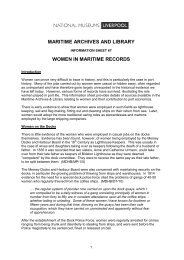
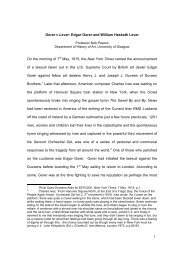
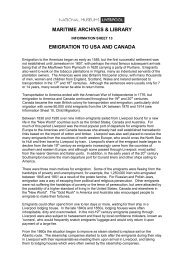
![Ancient Egypt trail [227kb .pdf] - National Museums Liverpool](https://img.yumpu.com/48998817/1/184x260/ancient-egypt-trail-227kb-pdf-national-museums-liverpool.jpg?quality=85)

